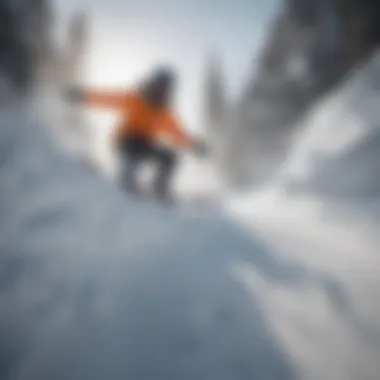Mastering the Slush Slasher: Snowboarding Guide


Intro
As any seasoned snowboarder knows, the experience of carving the slopes is not merely about speed and style, but also about adapting to ever-shifting conditions. Amidst the glistening white peaks, one phenomenon that frequently poses challenges is slush—packaged snow transformed by warming temperatures and relentless sunshine. This forms the backbone of discussion around the idea of the 'slush slasher.' In this guide, we venture into the intricate world of snowboarding under such tumultuous conditions, exploring the unique hurdles that slushy surfaces present and the strategies needed to conquer them.
Extreme Sports Overview
Definition of Extreme Sports
Extreme sports occupy a unique niche within the sporting realm. They often prioritize thrills, pushing personal limits, and confronting risk head-on. This isn't just about physical capability but also about mental resilience and skill. Snowboarding, particularly in slushy conditions, epitomizes this spirit, demanding a fine balance of technique and bravery.
History and Evolution
The roots of snowboarding trace back to the 1960s when visionaries like Jake Burton Carpenter helped shape what would become a mainstream sport. As the years progressed, the culture evolved, intertwining with the ethos of extreme sports. Slush riding emerged as a sub-genre, with its own code; where others see adversity, slushers see potential for creativity and individuality.
Popular Extreme Sports Disciplines
Snowboarding is just one of many extreme sports. Others like skateboarding, rock climbing, and BMX biking each possess their own allure. Yet, snowboarding uniquely combines speed, agility, and artistic expression. The rise of slush as a significant challenge has carved out a space where riders can innovate, introducing unique tricks and techniques that make this genre of snowboarding exciting to watch and participate in.
Understanding Slush Dynamics
Navigating slushy snow requires a solid grasp of slush dynamics. Unlike freshly fallen powder, slush can become unpredictable. During those warm afternoons when the snow is soft and sticky, the boards can sink deeper than expected. Proper weight balance and body positioning become crucial. The right approach means using your whole body to anticipate the next groove or bump, staying light on the feet, and being ready to adjust your technique on-the-fly.
Gear and Equipment
Appropriate gear stands as a cornerstone for thriving in slushy conditions. While typical snowboarding gear may suffice in powder, slush demands a specialized touch. Here are some essential items you should keep in mind:
- Board Type: Opt for a shorter and wider board to help maintain buoyancy in slush.
- Bindings: Choose softer flex bindings to enhance your maneuverability.
- Boots: Comfort is key, so look for boots that merge flexibility with support.
- Apparel: Breathable layers allow for moisture management, critical when temperatures rise.
With the right equipment, snowboarders can efficiently handle the unique challenges that slushy terrains present.
End
The concept of the slush slasher dwells at the intersection of challenge and creativity in snowboarding. By understanding the dynamics of slush, equipping accordingly, and honing riding techniques, both novices and seasoned athletes can enhance their performance and elevate their enjoyment in challenging snow conditions. Ultimately, the beauty of extreme sports lies in the thrill of conquering what seems insurmountable. Through this guide, we prepare you not just to ride, but to revel in every quirk and nuance that slushy snow brings.
Understanding Slushy Snow Conditions
In the world of snowboarding, each snow type presents unique challenges and riding experiences. Among these, slushy snow stands out for its unpredictable nature. Understanding slushy conditions is not just an interesting factoid; it's a vital precursor to mastering the art of slush slashing. When it comes to slushy terrain, several factors converge—temperature, precipitation, and altitude—all play a significant role in shaping the snow’s character. Knowing how these elements interact helps riders not only to navigate but to thrive in such conditions.
Characteristics of Slush
Slush isn’t just wet snow; it’s a unique blend of snowflakes that have partially melted, creating a semi-liquid texture that can be tricky to handle. This condition generally occurs when temperatures hover around freezing. The snow is often heavy, leading to a feeling of drag that can either hinder or enhance performance, depending on the rider's skill and technique. Slush varies in depth—a thin layer can be slippery, while a thick layer can provide a sticky feel making transitions challenging.
Some key characteristics of slushy snow include:
- Moisture Content: High moisture makes the snow pack heavy.
- Temperature Factors: The closeness to the melting point affects the slickness.
- Variability: From spot to spot, slush can range from creamy goodness to puddles of frustration.
Being aware of these characteristics helps riders anticipate how the board will react, leading to better handling and technique adjustments.
Weather Factors Affecting Slush Formation
Weather plays a critical role in creating slushy snow. Several elements come into play:


- Warm Fronts: These can bring rain or warmer air, which melts existing snow, creating slush.
- Humidity: Increased moisture in the air can keep the snow damp, preventing it from fully refreezing.
- Altitude: Higher elevations may still maintain drier powder. Meanwhile, lower elevation resorts experience slush formation more rapidly.
Understanding these factors can change a rider's approach. Recognizing when and where slush may form allows snowboarders to make strategic decisions about when to hit the slopes, and it can even dictate the choice of equipment.
Differences Between Slush and Powder
While both slush and powder are appealing in their own right, they behave rather differently under the board. A crucial aspect for any rider is understanding how these two snow types differ:
- Texture: Powder is light and airy, often described as fluffy, while slush is denser and heavier, offering a more substantial feel.
- Stability: Powder allows for smooth, flowing turns, while slush can create instability due to its wetness.
- Riding Technique: With powder, the goal often involves floating and gliding; in slush, riders must learn to adapt by slashing to maintain speed and control.
For those aiming to excel on the slopes, this knowledge is more than theory; it’s pivotal for transforming slushy challenges into exhilarating rides.
The Slush Slasher Technique
When it comes to snowboarding, mastering the unique technique of slush slashing is crucial for tackling challenging, slushy conditions effectively. The slush slasher technique encapsulates a range of skills and strategies that focus on maneuverability, control, and the enjoyment of each ride. Given the inherent complexities that slushy snow poses—from compacted wetness to varying textures—the techniques employed can drastically affect performance and safety on the slopes.
Essential Riding Skills
Edge Control
Edge control is one of the cornerstones of effective slush slashing. It refers to the ability to utilize the edges of the snowboard to acquire grip and maintain stability. In slushy snow conditions, having precise edge control makes all the difference, allowing riders to carve turns rather than skid uncontrollably. The key characteristic of edge control is its responsiveness; a well-timed edge engagement can help a snowboarder navigate through the slush with relative ease.
A unique feature of edge control is the leaning technique that comes into play—shifting body weight slightly forward can improve grip without overwhelming the board. While it might be tempting to just rely on downward force, this approach may lead to losing balance or getting stuck in deeper patches of slush. Furthermore, having sharp edges on your snowboard can enhance these effects, leading to a smoother ride.
Weight Distribution
The placement of weight on a snowboard has a direct impact on how one interacts with slushy terrain. Understanding weight distribution is essential for maintaining balance and facilitating smooth transitions from turn to turn. Riders often find that a centered stance works well in slush conditions, allowing for shift and sway without loss of control.
The unique feature of proper weight distribution lies in its adaptability; a rider can manipulate their position as the snow changes, from firmer sections to mushier spots. However, if the weight shifts too far back, it risks catching the tail of the board, causing an unexpected fall. Optimally distributing weight enables fluid movement, making it a valuable knowledge point for this journey into slush slashing.
Turning Mechanics
Turning mechanics define how smoothly and effectively a snowboarder can navigate slushy terrain. Proper turning technique is not merely about swinging your hips; it includes the coordination of body movements, momentum, and edge control. A significant characteristic of effective turning mechanics is the importance of a slow, gradual turn rather than abrupt shifts, which can lead to instability in slush.
The unique aspect here is how turns in slush can be more about finesse than aggression. Riders need to pivot smoothly, allowing the shape of their board to naturally guide their direction. One advantage of focusing on smooth turns is that it minimizes the risk of catching an edge, which is particularly common in slushy conditions. Thus, mastering turning mechanics is non-negotiable for any rider looking to embrace the slush.
Adjusting Your Stance
Narrow vs. Wide Stance
The stance width plays a vital role in stability when snowboarding through slush. Riders often face the choice between a narrow or wide stance, both of which have their merits. A narrower stance offers increased agility, allowing for quicker adjustments when navigating tricky patches. Conversely, a wider stance can provide more stability and balance, which can be particularly useful when tackling soft, uneven snow.
Each option possesses its own unique features. A narrow stance permits more freedom of motion but could lead to destabilization during unexpected slush interactions. On the other hand, a wide stance provides excellent support but may restrict one's ability to make quick, sharp movements. Understanding the differences can lead to a more customized approach in the trek through slushy terrains.
Foot Placement Adjustments
Foot placement adjustments are another critical aspect of slush slashing. Where a rider positions their feet on the board can dramatically influence the overall experience. Generally, placing the back foot a bit more forward can enhance maneuverability, while keeping it back can offer stabilization against slush.
What makes foot placement adjustments so compelling is how they allow customization based on personal riding style and the riding conditions. If too much weight is placed on the front foot, a snowboarder may find it difficult to initiate turns; but too much on the back can lead to imbalance. Grasping the nuances of foot placement is all about finding that sweet spot which can enhance performance.
Carving vs. Slashing


Carving emphasizes clean, precise turns where the edge of the snowboard cuts through the snow, generating speed and stability. This technique is often preferred on firmer snow but can be challenging in deep slush due to the soft texture of the snow, which can cause the board to sink or clip.
Conversely, slashing entails a more dynamic movement, often involving quick, lateral shifts that can create playful sprays of snow, enhancing the fun factor while allowing for better recovery in slushy conditions. A balance between carving and slashing is vital, allowing snowboarders to adapt their technique depending on how the snow behaves during rides. Riders often find joy in mixing both, capitalizing on each style's strengths to master the slush.
Gear Selection for Slushy Conditions
Selecting the right gear for slushy conditions can make or break your snowboarding experience. In warmer temperatures, slushy snow creates a unique riding environment that requires thoughtful consideration of your equipment. The right choices can enhance your ride, ensuring both performance and comfort.
Choosing the Right Snowboard
Flexibility and Responsiveness
This topic ties right into how a snowboard handles under different conditions. A flexible snowboard is crucial for adapting to slushy snow, as it allows for better maneuverability. When you're cruising over slush, responsiveness matters—you want your board to react promptly to your movements. Stiff boards may not give you that luxury, leading to a clumsy ride. This flexibility is generally regarded as beneficial, as it permits a more playful style, especially needed when navigating tricky conditions.
Material Considerations
Selecting the right materials can significantly affect performance. Many boards are constructed with a variety of materials, each contributing differently. For slushy conditions, boards with a good mix of lightweight materials such as polymer topsheets can reduce drag. The texture also plays a key role: a smoother base will glide more efficiently through slush. It's essential to keep in mind that while some materials improve speed and lightness, they may reduce durability, so finding a balance is key.
Optimal Bindings and Boots
Types of Bindings
When considering bindings, think stability and adjustment. Slushy conditions often necessitate a strong connection to your board. There are different types, like strap-in bindings, which offer a secure fit. They allow you to easily release when necessary but hold firm during your ride. If you opt for a type with high backs, it can help with stability in turns, especially when the snow gets heavy. A well-designed binding can be a game-changer when trying to maintain control and balance in slush.
Boot Fit and Support
Getting your boots right is a critical element. A snug fit may help with responsiveness, providing a more direct feel with your board. Well-supported boots also protect against fatigue, which can be a real concern in slushy conditions where you'll expend more energy. Look for boots that offer both comfort and support while allowing for movement—having the right fit can greatly affect your ride.
Clothing and Equipment for Temperature Control
Weather plays an undeniable role in slushy conditions. Layering is your best friend. Start with moisture-wicking base layers, ensuring sweat doesn’t stay close to the skin. Insulation layers will keep you warm when needed, and a waterproof outer layer helps keep you dry on the wetter slopes. Gloves and goggles suited to warmer climates are also necessary; don’t skimp on these items as they can enhance even the simplest of rides.
Safety Considerations in Slushy Conditions
Navigating the slopes during slushy conditions presents its own set of dangers and unique experiences. While many seasoned snowboarders embrace the soft and forgiving nature of slush, knowledge of safety considerations becomes paramount. Slushy snow—though oftentimes more manageable than hard pack—can give rise to unexpected hazards that can lead to injuries if one isn’t careful. Thus, understanding these risks is essential for anyone looking to shred the slopes safely.
Injury Risks Associated with Slush
When riding in slushy snow, various injury risks emerge, largely owing to the snow's unique texture and behavior. The most common injuries stem from both loss of control and the inherent instability of slush. Some prevalent risks include:
- Wrist and Ankle Injuries: The deep softness of slush can result in hard falls, particularly when a boarder doesn’t anticipate the sudden ‘grab’ of a deeper patch. When you’re flying through slush, you might think you have it all under control until that snow unexpectedly slows you down, sending you sprawling.
- Knee Strain: Changes in weight distribution are crucial in slushy conditions. An improper stance or sudden shifts can put undue pressure on your knees, leading to strains or twists. Being aware of your movements can help mitigate this issue.
- Collisions: Slushy conditions often come with reduced visibility and a tendency for riders to lose track of their speed. Consequentially, riders might collide with fellow snowboarders or surrounding barriers if they aren't careful.
In summary, even though slushy slopes might seem inviting, they carry distinct risks. Mindfulness of these can make the difference between a thrilling ride and a trip to the first-aid station.
Proper Warm-Up and Stretching Techniques
Ensuring your body is properly prepared for the demands of slushy riding can significantly lower the risk of injury. A well-executed warm-up and stretching routine enhances flexibility and readiness for the snow ahead. Here are some steps that can help:
- Dynamic Stretching: Before hitting the slopes, engaging in dynamic movements such as leg swings, arm circles, and torso twists can get the blood flowing and warm up your muscles. This is especially useful in challenging conditions where agility is critical.
- Target-Focused Warm-Ups: Give particular attention to key muscle groups used during snowboarding. Focus on quads, calves, and hamstrings, crucial for maintaining balance and strength.
- Cool Down: After a long day treading through slush, be sure to cool down with gentle stretches. Think of this as giving your body a chance to relax and recover after aggressive efforts.
Maintaining flexibility through warm-ups can not only boost performance but can also save you from a nasty tumble when the weather or terrain conditions change unexpectedly.


To summarize, a thorough understanding of slushy conditions and preparation through injury awareness and proper warm-ups can transform a complicated ride into an enjoyable day on the slopes. Remember, safety doesn't take a vacation, even when the snow does.
Cultural Context of Snowboarding in Slushy Conditions
Snowboarding, as a sport and lifestyle, has grown beyond its initial appeal of adrenaline and thrill. Today, it embraces a cultural tapestry interwoven with elements of community, expression, and connection to the elements—especially evident when riding slushy conditions. Slush riding isn’t just a test of skill; it's a cornerstone of the snowboarding culture that reflects adaptation and innovation within a challenging environment.
In the world of slushy snowboarding, riders face unique obstacles that add richness to their experience. The soft, gooey snow requires a different mindset, transforming what might seem like an inconvenience into an opportunity for creativity. While powder days might garner more excitement, slush riding offers a chance for snowboarders to experiment and refine their tricks.
The Evolution of Slush Riding
Slush riding has evolved considerably over the years, influencing the styles and techniques of both seasoned athletes and newcomers alike. Gone are the days when heavy slush was viewed simply as sloppy conditions to avoid. Instead, riders have started to recognize slush as a playful medium where new tricks and styles can be developed. As snowboards grew more advanced, the transition to maneuvering through varying snow conditions became smoother. Slushy conditions offer unique opportunities to practice transitions and even some freestyle maneuvers that are difficult or impossible on powder.
Historically, slush was often associated with late-season outings, where the snow could change with the afternoon sun. Riders, unknowingly, created their own techniques and styles suited for slush—be it manual variations or creative line selections that would allow them to glide effortlessly across the surface. This evolution has gradually built a culture of respect and appreciation for the different types of snow, particularly over the last decade.
Personal Stories from the Slush Slasher Community
Community tales often resonate with humor, learning, and camaraderie, woven into the fabric of this unique type of riding. You can find stories about epic slush conquests that not only showcase skill but also emphasize resilience. For instance, a local snowboarding legend recalled his first attempt at a double backflip in slush. Many laughed afterward, not from failure, but from how the forgiving snow cushioned the fall. The slush allowed him to keep getting up and trying, turning a mishap into a cherished tale of determination.
In online forums and social networks, such as reddit.com or dedicated snowboarding Facebook groups, riders often share advice and humorous anecdotes. These narratives cultivate a sense of belonging, encouraging riders to embrace the 'slush slasher' identity. They inspire both novices and experts to ride through slushy messes, viewing them as a playground rather than a bane.
It's not unusual for a seasoned boarder to offer tips on how to handle unexpected bumps or tricky drops while navigating slush. The shared experiences and insights transform slushing from a mere snow condition into an opportunity for bonding within the snowboarding community. Through these personal stories, slush riding evolves as a cultural practice—an event that embraces the messy, the fun, and the oftentimes unpredictable nature of snow.
Expert Insights and Tips
Gathering wisdom from seasoned snowboarders is crucial for anyone interested in mastering the art of riding slushy snow. These insights, forged through countless descents, provide a deeper understanding of the peculiarities of slushy conditions. Having expert advice not only helps in refining techniques but also in enhancing safety and enjoyment during rides.
Interviews with Professional Snowboarders
When it comes to snowboarding, the voices of professionals resonate with authenticity and experience. Their journey through different terrains, including the often-tricky slushy slopes, reveals various techniques adapted for optimal performance. For instance, Jake Blauvelt, a renowned professional snowboarder, shares his two cents: "Riding slush feels like surfing on butter. It’s all about balance and timing. Shift your weight smoothly and let the board do the work."
Another top-rider, Sage Kotsenburg, emphasized the importance of using one’s edges effectively. "In slush, you need to be lighter on your feet. Digging your edges too much can bog you down. Keep it fluid and let your body naturally flow with the snow."
These nuggets of wisdom highlight how each esteemed snowboarder has developed a unique approach based on personal familiarity with snow conditions. Adding contexts such as training regimens, drills, and specific feedback on gear they've used can greatly enrich the reader's understanding.
Community-Shared Tips and Tricks
Beyond the pros, many passionate enthusiasts share valuable insights that come from real-world experiences. The snowboard community thrives on these tips, often exchanged in forums like Reddit or local meetups. Here are a few cherished tips:
- Speed Control: To ride effectively in slush, maintain a steady speed. Too slow, and you’ll sink; too fast, and you might end up tumbling. Find that sweet spot.
- Lean Back Slightly: Shifting your weight just a tad back can help in maintaining speed while preventing the nose of the board from diving too deep into the snow.
- Use Finesse Over Force: Many riders make the mistake of brute-forcing their turns. In slush, finesse and gentle movements can reap more rewards, as they allow the board to glide rather than grab.
A prominent online figure in the snowboarding community noted, "After lots of runs, I learned slush is about letting go of the old habits and embracing a more playful style. Don’t get tense; keep it fun."
The community resonates with a shared love for the sport. Individual insights often reinforce collective understanding, and it’s here that tricks become sharpened, leading to better rides overall.
Epilogue
The exploration of snowboarding in slushy conditions presents an important aspect of the broader snowboarding experience, stressing both challenges and benefits that come with mastering these unique environments. By delving into the techniques, gear selection, and safety considerations specifically tailored for slush conditions, riders are better equipped to enjoy their sport year-round.
The Dynamics of Slushy Riding
A key takeaway from this article is understanding how slushy snow behaves differently than powder or ice. Slushy snow can often feel like a mixture of both worlds, with varying depths and textures posing distinct challenges. Riders need to adapt their techniques in real time, fostering a deeper connection with their board and the snow beneath their feet.
Skill Development and Confidence
Moreover, honing skills for slushing can considerably bolster a rider's confidence. When snowboarders learn to maneuver effectively in these challenging conditions, they cultivate a more exquisite sense of balance and timing, valuable for any terrain they will encounter later on. Best of all, pushing through the challenges of slush conditions can transform an average day on the slopes into an exhilarating adventure.
Community and Culture
Furthermore, the cultural implications surrounding slushy riding cannot be overlooked. Engaging with communities online, such as through forums or social media platforms, grants riders access to personal stories, tips, and encouragement from like-minded enthusiasts. This sense of camaraderie can spark excitement and motivation, encouraging novices to tackle slushy slopes with ambition rather than apprehension.







